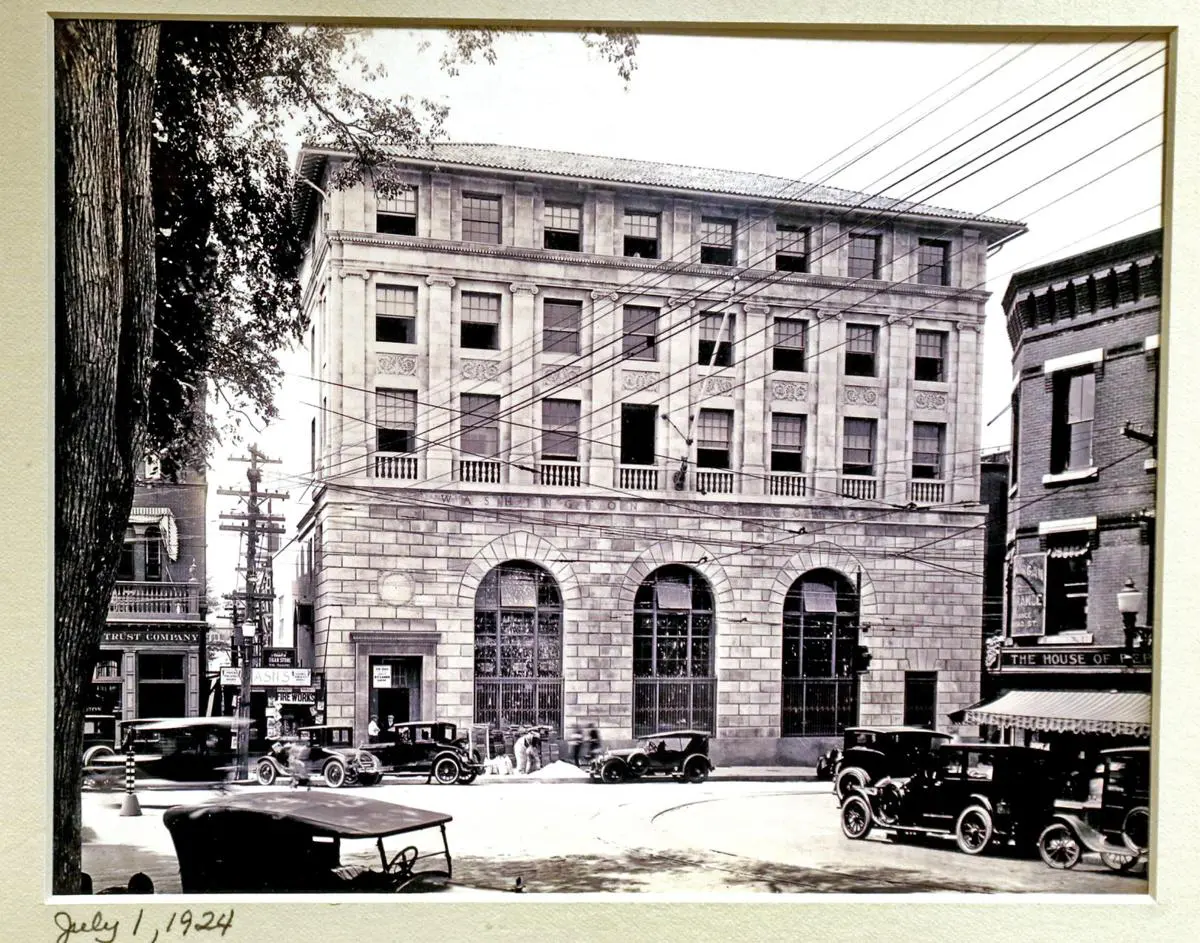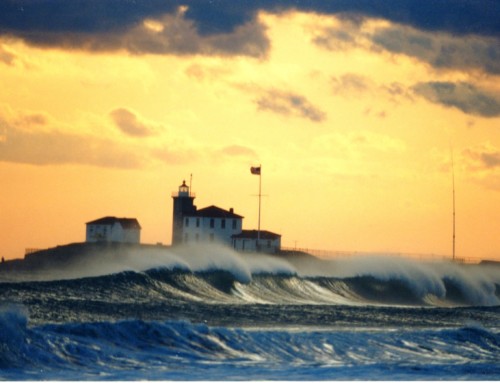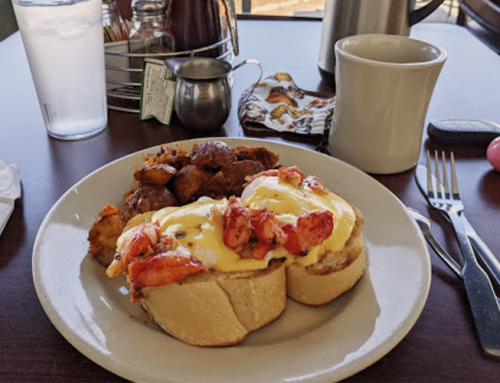As the Washington National Bank crossed over into their second century serving the citizens of Westerly, operations were steady despite an increasingly crowded field. In 1900, there were eight banks operating in Westerly, but this absolute abundance was not to last. By 1904, only three of those banks were still in operation,[1] and by 1911, only Washington Trust remained.[2]
At the turn of the century, Albert L. Chester was serving as the President of the bank, a position he held until 1906.[3] During his presidency, the entire interior of the bank was remodeled, updating several of the facilities to meet the needs of an ever-changing world.[4] These updates were necessary due in part to the increased demand. At the start of the 20th-century, there were 3,000 saving accounts open with the bank with a total of $1.7 million invested.[5]
In 1901, Washington National Bank played a significant role in the consolidation of banks in Westerly when they purchased the Phenix Bank which had been in operation since 1818.[6] To obtain the bank’s assets, Washington National outbid the Industrial Trust Company and the Manufacturer’s Trust Company with an offer of $68.25 per share.[7] Three years after the acquisition of the Phenix Bank, the Washington National Bank made perhaps the biggest move in its history to that point, merging with the Westerly Savings Bank. In doing so, the bank became a state institution and organized as a trust company, allowing it to take on the name Washington Trust Company.[8]
On the 100th anniversary of Thomas Perry being named the bank’s cashier, his grandson, Charles Perry, was named the President of Washington Trust, continuing the legacy of Perry men serving at the bank.[9] While the early 20th-century was certainly a prosperous time for the bank as a whole, this period was not without its challenges. In 1907, a financial crisis struck the nation, and many state and local banks were drawn into bankruptcy. Washington Trust, however, was able to pay all of its customers in full and on demand, reflecting the bank’s financial stability at the time.[10] This healthy financial situation was also reflected in the 5,455 savings accounts opened with the bank in 1910, nearly twice the 3,000 that were open in 1900. This was evidence of both the bank’s success and also changes in the ways that Americans used their money.[11] The following year, the bank had assets totaling $4.7 million, also more than twice as much as in 1900.[12]
Washington Trust continued their trend of acquiring local banks with their purchase of the First National Bank of Hopkinton in 1914. The First National Bank which opened its doors in 1865, was the only national bank in the state that did not accept the provisions of the national reserve banking system. The institution subsequently went into liquidation and Washington Trust took over all accounts on April 26, 1914.[13] This move allowed Washington Trust to open a branch in Hope Valley, expanding their reach locally.[14]
In April 1917, the United States entered World War I and shortly thereafter, Washington Trust got involved in the war effort by selling war bonds. Westerly residents purchased $2,398,450 worth of these bonds from the bank in 1917.[15] The 1910’s were also highly successful for the bank, as the number of checking accounts once again doubled during the decade, a 400% increase from the total in 1900.[16]
The 1920’s were financially prosperous for many Americans, a fact which was evident in the significant changes which occurred at Washington Trust over the course of the decade. In 1920, increased business necessitated the construction of a temporary wooden building which was put to use until a new building was completed on the same site.[17] In November 1922, the “little Greek temple” building, which was to be torn down, was purchased by Frank Sullivan of the Sullivan Granite Company, likely so that the granite components of the building could be reused for other projects.[18]
1924 saw the completion of the dismantling of the original Washington Trust Building allowing the new building to be constructed on the same site on the corner of Broad and Main Streets.[19] The vault from the previous building was retained with the new building being built around it.
According to one account: “Graced by a main banking room of striking proportions and equipped with every modern facility for the conduct of business, it provides a worthy setting for an institution which has progressed without faltering.”[20] On January 1, 1925, the new Washington Trust Building officially opened for public viewing.[21]
Just as the 1920’s were marked by great financial gains, the 1930’s brought about hard times for many in America. Washington Trust persevered through the Great Depression much as they had during several other economic crises and in 1931, to help locals to weather the storm, the bank opened a small loan department.[22] Conservative policies throughout the 1920’s allowed Washington Trust to remain open throughout the Depression including the 1933 Bank Holiday during which many banks closer their doors for good.[23]
The success of the small loan department made it clear to those in power at Washington Trust that an expansion of customer services would be beneficial. As a result, between 1941 and 1945 while the country was in the midst of the second World War, the bank launched consumer loan and money management services.[24] Just as it had immediately after World War I, America encountered a decade of economic success in the 1950’s. According to a history of the bank published in 1950: “The last five years have brought brisk business, an expanding resumption of resort activities, [and] extensive building operations. While looking to the past with fond regard, Westerly looks to the future with enthusiastic faith.”[25]
After more than 150 years of performing tabulations and calculations by hand, Washington Trust received their first electric calculator in 1959, greatly expediting the work of many bankers.[26] Technological advances were a frequent occurrence in the second half of the 21st-century. In 1965, the bank opened its first two drive-through windows in an effort to provide customers with quicker and more convenient means of banking.[27]
The future was rapidly approaching, as evidenced by the 1970 installation of a Honeywell 1250, the bank’s first computer. This computer, which was the size of a full room, was the cutting edge of technology at the time despite the fact that it possessed only 16 K of memory.[28] That same year, the computer system was put to further use when a new building was constructed in Richmond and this branch was linked by computer to the main office in Westerly.[29] Six years later, a new computer system was installed which allowed the branches in Westerly and Hope Valley to work together.[30] Shortly thereafter, the bank introduced one of their most innovative concepts to date, the “One Account.” This account combined “the convenience of savings, checking, and loan account all in one.”[31]
In the 1980s, Washington Trust continued to expand both in Westerly and throughout Rhode Island. 182 years after the opening of the first location in downtown Westerly, the bank opened the Franklin Street facility in their hometown.[32] Two years later, the first, and so far only, the offshore building was opened on Block Island.[33] As the 1980s came to a close, two additional branches were founded with the Charlestown branch opening in 1988 and the Narragansett branch following a year later.[34]
As the new millennium approached, Washington Trust began to invest in new public-facing technology which would significantly improve the user experience for account holders. These improvements were likely a contributing factor in the decision by Money magazine to name Washington Trust the best bank in Rhode Island in 1996.[35] In 1999, the bank launched their website and the following August, online banking was available for the first time. On August 22, 2000, Washington Trust celebrated their two hundredth anniversary.[36] Banking from the convenience of one’s own home would never have been dreamed of when the bank first opened their doors to the public two centuries prior. In the 20 years since the bank celebrated their 200th anniversary, they have continued to innovate while also providing dependable service to their accounts.
[su_accordion class=””] [su_spoiler title=”Footnotes” open=”no” style=”default” icon=”plus” anchor=”” class=””]
- “Will Take Over Bank” Providence Evening Bulletin, 25 February 1904.
- “The Washington Trust Company of Westerly, Rhode Island” The Banker’s Magazine, vol. LXXXIII, 1911, pg. 248.
- Cooney, Ralph Bolton, Westerly’s Oldest Witness: How Westerly and the Washington Trust Company Have Progressed Together for 150 Years, (1950), pg. 81.
- “The Washington Trust Company of Westerly, Rhode Island” The Banker’s Magazine, vol. LXXXIII, 1911, pg. 250.
- Cooney, Ralph Bolton, Westerly’s Oldest Witness: How Westerly and the Washington Trust Company Have Progressed Together for 150 Years, (1950), pg. 53.
- The Washington Trust Company, One Hundred Years of Banking in Westerly, (Westerly, RI, 1908).
- “Providence Trust Concerns Were Bidders, but the Washington National Bank Was the Highest Bidder for the National Phenix Bank of Westerly” Providence Evening Bulletin, 31 May 1901.
- “The Washington Trust Company of Westerly, Rhode Island” The Banker’s Magazine, vol. LXXXIII, 1911, pg. 250.
- “A Full Century” Providence Evening Bulletin, 29 January 1906.
- “The Washington Trust Company of Westerly, Rhode Island” The Banker’s Magazine, vol. LXXXIII, 1911, pg. 250.
- Cooney, Ralph Bolton, Westerly’s Oldest Witness: How Westerly and the Washington Trust Company Have Progressed Together for 150 Years, (1950), pg. 57.
- “The Washington Trust Company of Westerly, Rhode Island” The Banker’s Magazine, vol. LXXXIII, 1911, pg. 248.
- “The First National Bank of Hopkinton” Norwich Morning Bulletin, 20 March 1914.
- Cooney, Ralph Bolton, Westerly’s Oldest Witness: How Westerly and the Washington Trust Company Have Progressed Together for 150 Years, (1950), pg. 59.
- Washington Trust, Celebrating 200 Years of Service, Westerly Sun Insert, 20 August 2000.
- Cooney, Ralph Bolton, Westerly’s Oldest Witness: How Westerly and the Washington Trust Company Have Progressed Together for 150 Years, (1950), pg. 65.
- “Westerly.” Providence Evening Bulletin, 19 March 1920.
- “Westerly.” Norwich Morning Bulletin, 3 November 1922.
- Washington Trust, Celebrating 200 Years of Service, Westerly Sun Insert, 20 August 2000.
- Cooney, Ralph Bolton, Westerly’s Oldest Witness: How Westerly and the Washington Trust Company Have Progressed Together for 150 Years, (1950), pg. 68.
- Washington Trust, Celebrating 200 Years of Service, Westerly Sun Insert, 20 August 2000.
- Cooney, Ralph Bolton, Westerly’s Oldest Witness: How Westerly and the Washington Trust Company Have Progressed Together for 150 Years, (1950), pg. 72.
- Cooney, Ralph Bolton, Westerly’s Oldest Witness: How Westerly and the Washington Trust Company Have Progressed Together for 150 Years, (1950), pg. 72.
- 200 Washington Trust, Celebrating 200 Years of Service, Westerly Sun Insert, 20 August 2000.
- Cooney, Ralph Bolton, Westerly’s Oldest Witness: How Westerly and the Washington Trust Company Have Progressed Together for 150 Years, (1950), pg. 76.
- Chalk, Sandra Kersten, Washington Trust: Two Hundred Years Along the Pawcatuck, (2000), pg. 89.
- Chalk, Sandra Kersten, Washington Trust: Two Hundred Years Along the Pawcatuck, (2000), pg. 93.
- Chalk, Sandra Kersten, Washington Trust: Two Hundred Years Along the Pawcatuck, (2000), pg. 96.
- Washington Trust, Celebrating 200 Years of Service, Westerly Sun Insert, 20 August 2000.
- Chalk, Sandra Kersten, Washington Trust: Two Hundred Years Along the Pawcatuck, (2000), pg. 98.
- Chalk, Sandra Kersten, Washington Trust: Two Hundred Years Along the Pawcatuck, (2000), pg. 103.
- Washington Trust, Celebrating 200 Years of Service, Westerly Sun Insert, 20 August 2000.
- Washington Trust, Celebrating 200 Years of Service, Westerly Sun Insert, 20 August 2000.
- Washington Trust, Celebrating 200 Years of Service, Westerly Sun Insert, 20 August 2000.
- Washington Trust, Celebrating 200 Years of Service, Westerly Insert, 20 August 2000.
- Washington Trust, Celebrating 200 Years of Service, Westerly Sun Insert, 20 August 2000.[/su_spoiler] [/su_accordion]






